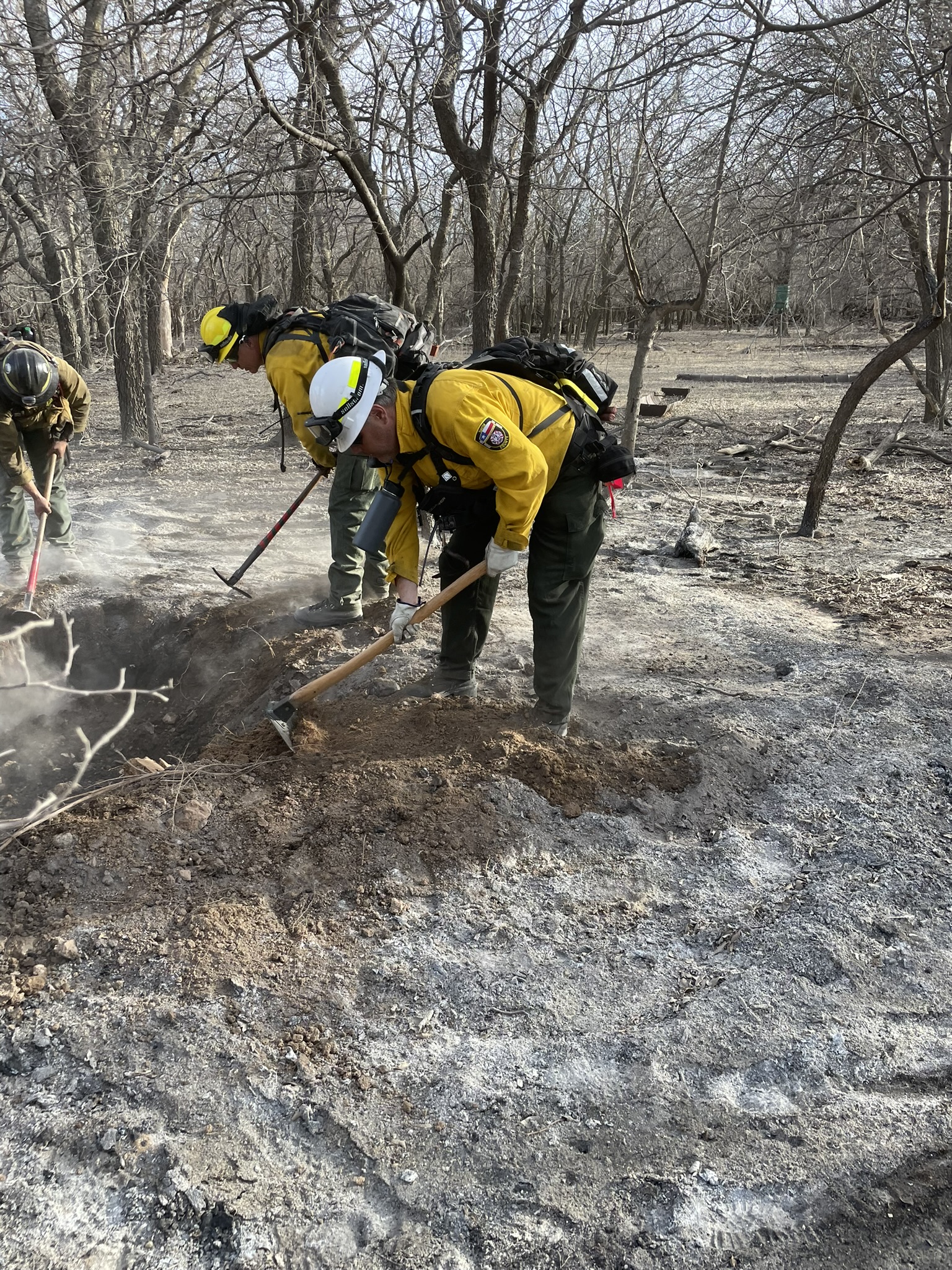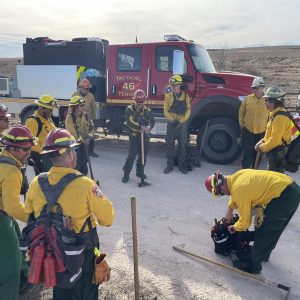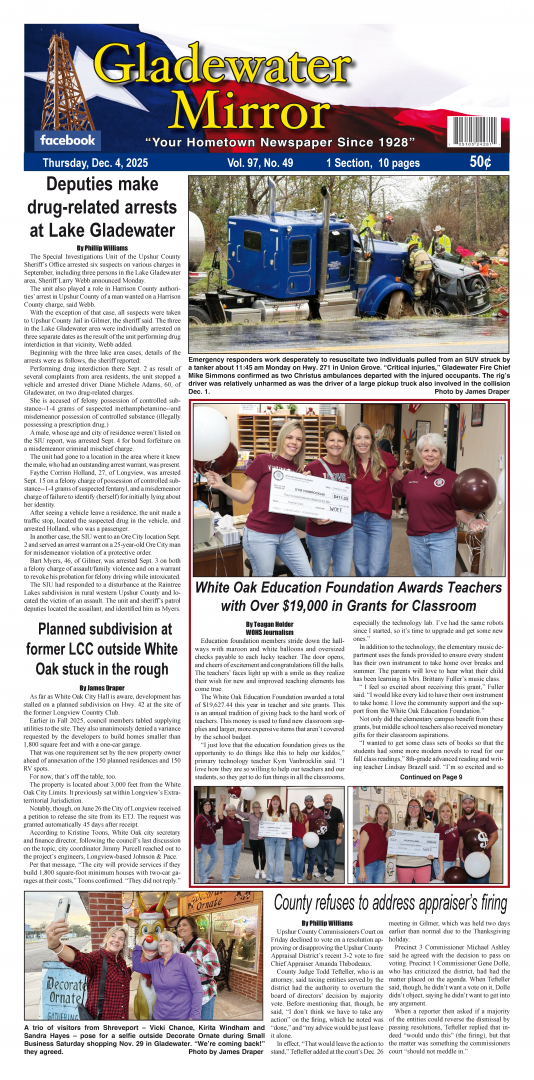 The largest wildfire in Texas history continues to ravage vast portions of the Panhandle, and as firefighters contain the destruction of the Smokehouse Creek fire and other blazes, East Texans are helping hold the line.
The largest wildfire in Texas history continues to ravage vast portions of the Panhandle, and as firefighters contain the destruction of the Smokehouse Creek fire and other blazes, East Texans are helping hold the line.
The record-setting wildfire began Monday, Feb. 26, in Hutchinson County. According to data being collected by Texas A&M Forest Service, it quickly grew from 100,000 acres to half-a-million the first day. By Feb. 28, it had burned 850,000 acres and has since exceeded 1.1 million.
It’s just one of five active wildfires burning in the Panhandle, and firefighters have been dispatched from throughout the state and across the country to assist. The draft includes local firefighter Josh Bardwell, West Mountain Volunteer Fire Department Chief and Smith County Emergency Service District No. 2’s coordinator with the Texas Intrastate Fire Mutual Aid System (TIFMAS).
“This things so dadgum big,” said Bardwell, son of Gladewater Mirror Publisher Jim Bardwell. “This fire is so large that we have many different divisions and base camps geographically set up – we know the overall mission and overall operations, but we’re not in communication because the fire is so long.”
Bardwell’s working as Strike Team Leader with TIFMAS, running the five units of Engine Strike Team 115 as they help hold a fire-line almost 107 miles-long.
“Smith County ESD No. 2 was ordered up along with hundreds of firefighters from other departments,” Bardwell confirmed. “We’re operating out of Borger, Texas, base camp. Our main area of operation is the western side of the Smokehouse Creek fire north from the town of Stinnett all the way over to southwest of Spearman.”
The team includes a brush truck from Smith Co. ESD-2, a brush truck and water tender from Austin Fire Department, plus brush trucks from departments in Georgetown and Beaumont. They were dispatched to the Panhandle two days after the blazes began.
“We had an immediate request through the TIFMAS program to get a strike team assembled and on the road as soon as we could the morning of the 28th to get here to the fire, which was actively burning.”
The strike team includes 15 personnel along with the equipment gathered from across the state: “We’ve been very fortunate that we have very good people who are very competent and doing a great job.”
The cause of the Smokehouse Creek fire is still under investigation, with early reports focusing on a downed power line near Stinnett.
It’s likely hundreds of homes have been damaged or destroyed by the five Panhandle wildfires. Thousands of livestock animals are dead, crops have been reduced to ash and officials are still working to assess the scale of the destruction as the wildfires keep burning. Amid a rash of evacuation and shelter in place orders, Gov. Greg Abbott’s disaster declaration covered 60 counties.
 As reported by the Texas Tribune, numbers from the Texas Department of Agriculture put more than 85 percent of the state’s cattle population on ranches in the Panhandle, and the fallout for the state’s agriculture industry is expected to be enormous.
As reported by the Texas Tribune, numbers from the Texas Department of Agriculture put more than 85 percent of the state’s cattle population on ranches in the Panhandle, and the fallout for the state’s agriculture industry is expected to be enormous.
The other active wildfires include (as of March 5) Grape Vine Creek Fire in Gray County, 60 percent containing after burning almost 35,000 acres; Windy Deuce Fire in Moore County (144,206 acres, 55 contained); Magenta Fire, Oldham County (3,297 acres, 85% contained; and another Hutchinson county fire, Roughneck (est. 300 acres, 50 percent contained).
As of Tuesday morning, Texas A&M Forest Service’s Current Situation status put the Smokehouse Creek fire in excess of 1.07 million acres burned and about 15 percent contained eight days from inception.
View a map of the Panhandle fires via tinyurl.com/SmokehouseCreek
“We have our chunk of ground, and we know what’s happening to the right of us and left of us.”
Morning operations calls give insight into the day’s grand plan, Bardwell said, then the team may not see anyone else the rest of the day except for immediate neighbors as they watch the fire-lines, check buildings and coordinate with property owners.
“The weather’s really been on our side,” Bardwell said. “Being that it’s a high plains fire, there was a lot of activity the first couple of days then it moderated due to the hard work of a lot of firefighters and the weather changing. We’re not running into many problems as far as fire escaping,” thanks to diligent monitoring.
“It’s making good progress. We haven’t had any new escapes on it. Minimal to no fire behavior. We’ve had good weather… good humidity, low wind. We haven’t been in red flag conditions the past couple of days which has made things very beneficial to firefighters. Whatever we are finding and putting out is staying out right now.”
According to Texas A&M Forest Service, fire environment conditions will moderate this week, reducing the threat for new, large wildfires.
“Cooler temperatures and less wind will aid in the ongoing suppression efforts for active wildfires. An underlying risk for new wildfires will continue in the Texas Panhandle and South Texas until spring green-up in occurs in the abundance of grass vegetation found in these regions.”
The fire crews are glad for any form of reprieve, but they can’t let up.
“You can look out over the wildfire and not see smoke coming up, but that doesn’t mean we should be complacent. We’re still putting boots on the ground: going through every creek bottom, every drainage ditch, every structure, every place the fire could be to make sure there’s nothing we’ve missed.”
It requires a lot of firefighters putting a lot of miles on their feet and their fire engines to get in and get the job done.
“I suspect this will have eyes on it for quite a while. It did greatly impact the town of Stinnett, parts of Pampa, Canadian… the State of Texas is here making sure these folks don’t have to go through that again, if at all possible.”
While the immediate task is to help the people on the ground in the Panhandle, in a wildfire situation Bardwell’s mind always goes back to home and how lessons learned in the field can help locals in Gregg County, Upshur and Smith.
The key theme out of this experience: Make your home defensible against fire – now, not later.
“Unlike a lot of places in the country, the State of Texas can potentially have a year-round fire season. Just because this large fire occurred now, doesn’t necessarily mean it’ll be worse or easier. We can’t predict what the fire season’s going to be just yet.”
Vegetation’s been thriving from healthy rains, he said, and homeowners need to be aware if that growth is encroaching on their home, i.e. fuel for a fire, up close and personal.
“Take those precautions now to clean up around your houses, create a defensible space that allows firefighters to protect the structure in the event of a wildlife,” he said. “Make the house more resilient and able to withstand a wildfire in the event one occurs
“A lot of the structures and homes we’ve seen that have burned here had dry vegetation really close to it or there was a way for embers to get under the homes, into the eaves… It’s imperative that the public does what they can do to try and harden their homes to reduce the chance of a wildfire causing damage.”
– By James Draper









